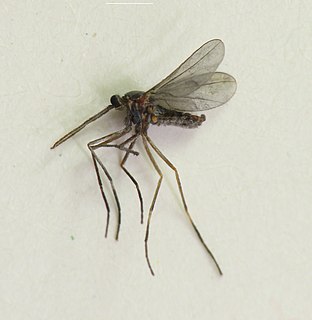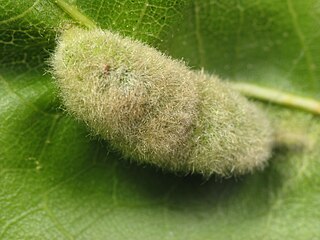
Cecidomyiidae is a family of flies known as gall midges or gall gnats. As the name implies, the larvae of most gall midges feed within plant tissue, creating abnormal plant growths called galls. Cecidomyiidae are very fragile small insects usually only 2–3 mm (0.079–0.118 in) in length; many are less than 1 mm (0.039 in) long. They are characterised by hairy wings, unusual in the order Diptera, and have long antennae. Some Cecidomyiids are also known for the strange phenomenon of paedogenesis in which the larval stage reproduces without maturing first. In some species, the daughter larvae consume the mother, while in others, reproduction occurs later on in the egg or pupa.

Asphondylia is a cosmopolitan genus of gall midges in the family Cecidomyiidae. All species in this genus induce galls on plants, especially on flowers and flower buds. There are over 300 described species in Asphondylia, with many more likely to be discovered and described, especially in the southern hemisphere. Within the genus, characteristics of the larvae and pupae are often most useful for distinguishing between species since adults of most species look very similar to one another. The species inducing a given gall can sometimes be identified based on the shape and placement of the gall in combination with the identity of the host plant.
Alycaulini is a tribe of gall midges, insects in the family Cecidomyiidae. There are about 20 genera and at least 200 described species in Alycaulini.
Polystepha is a genus of gall midges in the family Cecidomyiidae. There are more than 20 described species in Polystepha.
Celticecis is a genus of hackberry gall midges in the family Cecidomyiidae. There are about 18 described species in Celticecis.

Macrodiplosis is a genus of gall midges, insects in the family Cecidomyiidae. There are about 19 described species in Macrodiplosis.
Asphondylia betheli is a species of gall midge in the family Cecidomyiidae. This midge is widespread in the southwestern United States. The larvae of this species induce galls on in the fruit of Opuntia cacti.

Asphondylia helianthiglobulus is a species of gall midge in the family Cecidomyiidae. The larvae of this species induce galls on the stems of several sunflower species in eastern North America, including Helianthus giganteus,H. grosseserratus, and H. maximiliani.
Catotricha is a genus of gall midges and wood midges in the family Cecidomyiidae, the only extant genus in the subfamily Catotrichinae. There are about six described species in Catotricha. The subfamily also includes the extinct genus Mesotrichoca from the Tithonian aged Glushkovo Formation of Russia.

Asteromyia is a genus of gall midges in the family Cecidomyiidae. There are about nine described species in Asteromyia.
Cystiphora is a genus of gall midges in the family Cecidomyiidae. There are about seven described species in Cystiphora.
Haplusia is a genus of gall midges and wood midges in the family Cecidomyiidae. There are more than 20 described species in Haplusia.

Asphondylia solidaginis is a species of gall midge (Cecidomyiidae) that induces galls on goldenrods in North America where it is widespread. It was first described by William Beutenmuller in 1907.
Sackenomyia is a genus of gall midges, insects in the family Cecidomyiidae. There are about five described species in Sackenomyia.
Heteropeza is a genus of gall midges and wood midges in the family Cecidomyiidae. There are about six described species in Heteropeza.
Prodiplosis is a genus of gall midges, insects in the family Cecidomyiidae. There are about 11 described species in Prodiplosis.

Polystepha pilulae is a species of gall midge in the family Cecidomyiidae. It is found in eastern North America.
Raymond J. Gagné is an American entomologist whose work focuses on gall midges. He is a world authority on the family and has written many scientific articles on the taxonomy and biology of gall midges. Most of his work has been done as part of the USDA Systematic Entomological Laboratory at the Smithsonian Museum of Natural History.
Asphondylia antennariae is a species of gall midge in the family Cecidomyiidae. The larvae of this species induce galls on the buds of Antennaria plantaginifolia. This species is known from Wisconsin and Maine in the United States, though it's host plant is widespread in eastern North America. It was first described by American entomologist William Morton Wheeler in 1889.
Asphondylia artemisiae is a species of gall midge in the family Cecidomyiidae. The larvae of this species induce galls on at least one species of sagebrush Artemisia (plant). This species is only known from Arizona in the United States. It was first described by American entomologist Ephraim Porter Felt in 1908.





